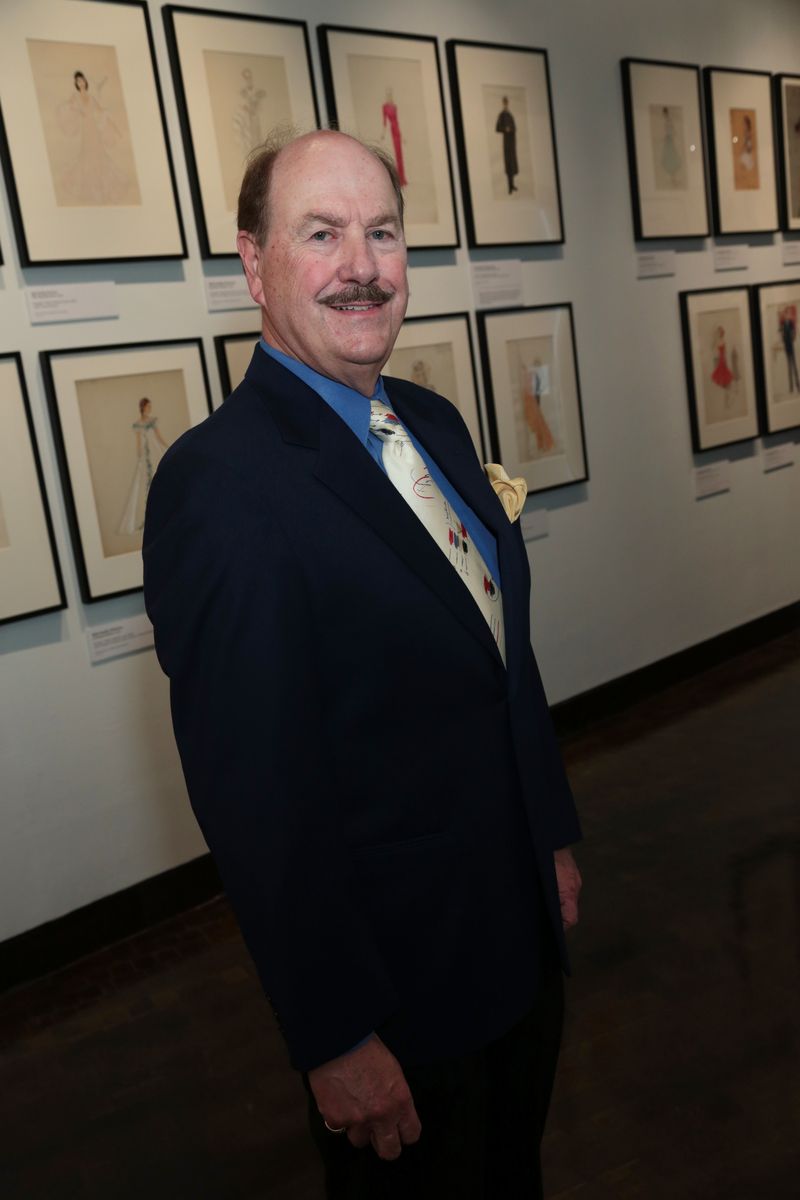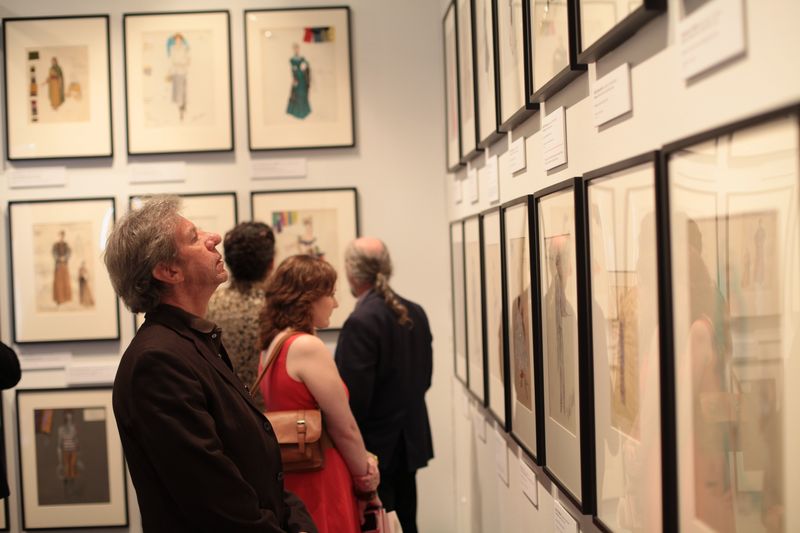Designing Hollywood: Sketches from the Christian Esquevin Collection is now open at the FIDM Museum! Through November 1, 2014, see selected sketches and costumes from Hollywood's Golden Age. Sketches featured in the exhibition were loaned to the FIDM Museum by collector Christian Esquevin. In the coming weeks, look forward to posts highlighting Designing Hollywood's five themes: Studios, Genres, Designers, Wardrobe, and Stars. Today, we talk with Mr. Esquevin about the origins of his collection and his favorite costume sketches.
 Christian Esquevin, Exhibition Guest Curator, at the opening of Designing Hollywood: Sketches from the Christian Esquevin Collection.
Christian Esquevin, Exhibition Guest Curator, at the opening of Designing Hollywood: Sketches from the Christian Esquevin Collection.
When did you start collecting costume sketches?
I started over 25 years ago when I inherited some costume sketches from my great aunt who had worked in wardrobe at the RK0 and other studios. While trying to identity some of the unknown actresses and films represented by those sketches, I began research that got me more interested in costume designs from the 1920s and 30s. I became friends with the late Satch LaValley who was another serious collector, although he also collected costumes, sketches, photos, and magazines. I started buying his sketches, and going to the Hollywood memorabilia shows. Costume sketches would also come up for sale at the auction houses that would have “Entertainment” auctions, which eventually became a booming business. The early days of eBay was like gold being discovered in California. You could search for weeks and find nothing and then you’d hit this big gold nugget – this obvious rarity that just popped up out of nowhere. I bought from other collectors – the prices were higher but they had already picked the better quality items. I always liked finding a group of sketches, even a collection, which came out of an estate or directly from an heir. It gave me a sense of continuity and connection to the actual design of the costumes and production of the film.
What attracted you to collecting costumes sketches, rather than collecting costumes?
I was an art major through most of my schooling, so fine art and illustration have always appealed to me. Fabric interests me also, but I knew I would never be able to store and care for costumes the way they would require. The storage requirements [for costumes] alone are daunting, and the preservation and repair considerations are overwhelming. I’m too much of an acquirer to be diverted by these other considerations.
 Sketch by famed Los Angeles costume designer William Travilla from an unknown film.
Sketch by famed Los Angeles costume designer William Travilla from an unknown film.
Do you have a favorite sketch? If it’s too hard to select just one, pick a few!
I do have many, many favorite sketches. Some because of their beauty, some because of their rarity or historical importance, some because of their panache, and some because of the circumstances of how I acquired them. There is the costume sketch of Rudolph Valentino done by Adrian for Valentino’s last film, Son of the Sheik in 1926. It is very rare. The Valentino films were Adrian’s first launch into Hollywood, and his designs for men’s costumes virtually stopped after Valentino. There is the costume sketch of Cyd Charisse designed by Walter Plunkett for Singing in the Rain, used in the Broadway Melody ballet scene. It has Plunkett’s dedication note to Cyd Charisse at the bottom, and the sketch came from her own estate. Another favorite is a sketch done for the first Ben Hur in 1925, a design by Harold Grieve for Ramon Navarro. It is very rare: a tall sketch of Navarro in Roman battle dress, which he wears in the film’s long finale. And there’s the sketch by Travilla for Sharon Tate in Valley of the Dolls. It’s barely seen in the move but the sketch has so much panache. And I can’t pass up the beautiful sketch of Elizabeth Taylor in Raintree County. This was a Civil War era movie that Plunkett considered even more ambitious than Gone with the Wind. And then again there’s a collection of sketches I got from the daughter of costume designer Mary Wills – which includes groups of sketches from such films as The Virgin Queen, The Wonderful World of the Brothers Grimm, Hans Christian Andersen, and Carousel. It’s wonderful to be able to preserve groups of sketches from the same film as they so often get broken up and scattered. I could go on.
Is there a “holy grail” sketch that would complete your collection?
I can’t say that there is one sketch that would do this for me. In any case the ones I would want are virtually unobtainable. The Gone with the Wind sketches are in institutional hands for the most part. Sketches by Adrian for his leading actresses: Garbo; Crawford; Harlow; Lamarr; Greer; Hepburn; Garland, etc., are as scarce as hen’s teeth since almost all of them were destroyed. Travis Banton’s costume sketches for Marlene Dietrich are mostly at the Academy of Motion Pictures Arts & Sciences’ Herrick Library. The others for Carole Lombard or Claudette Colbert are who knows where. Perhaps some of these will turn up some day. But there are so many excellent designers. I have no costume sketches from Robert Kalloch, a great designer who did wonderful costume illustrations. So there are still many challenges. And to make it clear, I collect costumes sketches from the classic era through the 1960s – with a few later ones. There are several excellent costume designers working today, but I have to limit myself at some point.
What’s the one thing you’d like visitors to take away from Designing Hollywood?
I think to appreciate the sketches not only for their visual interest and beauty, but what back-story they represent. These sketches are what resulted from a designer thinking long and hard about what a film character should look like based on the screenplay. The sketch on paper or board is what got passed around among the principles in the film’s making, and then by all the people involved in fabrication. And then the sketch had no other value and was left to its own fate. Certainly the studios no longer cared what happened to them, and most of them perished. We are all fortunate to have these examples to view and to appreciate the amount of work that went into costume design and film production in the golden age of Hollywood.
 Guests at the opening night celebration for Designing Hollywood.
Guests at the opening night celebration for Designing Hollywood.

